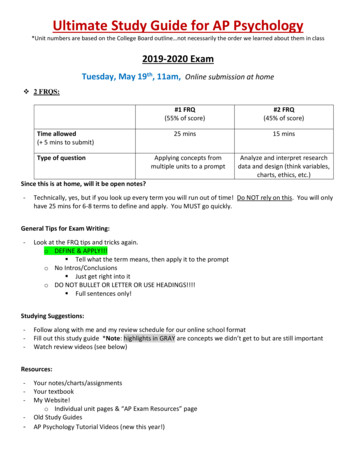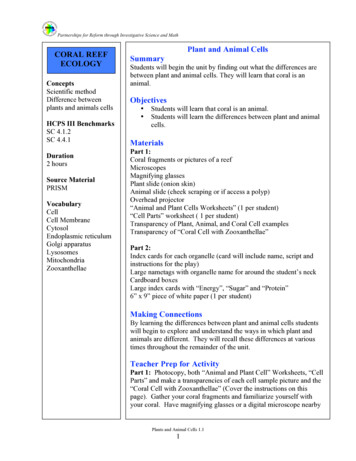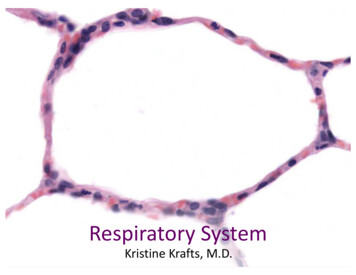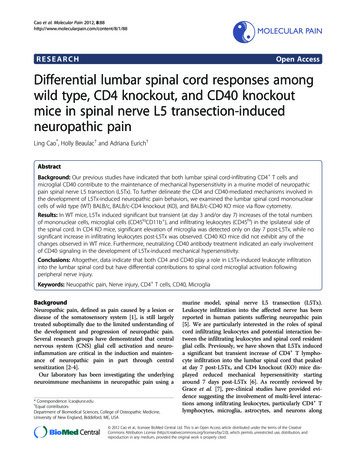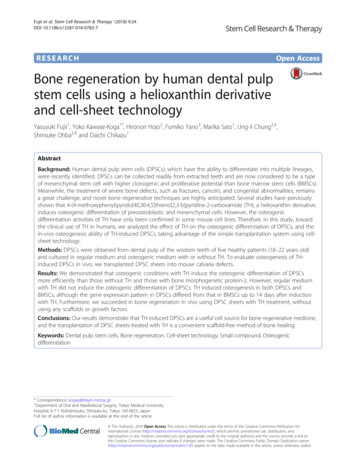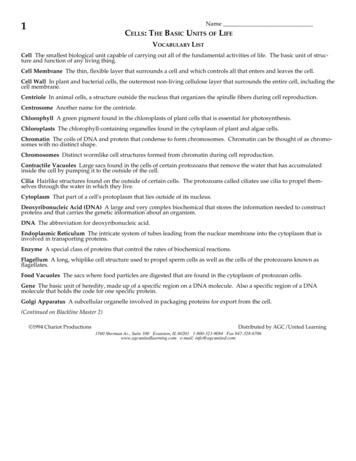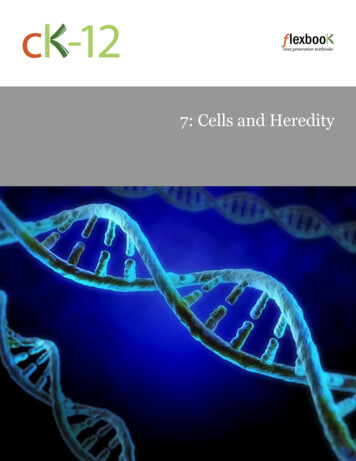
Transcription
7: Cells and HeredityLaura EnamaJean Brainard, Ph.D.Say Thanks to the AuthorsClick http://www.ck12.org/saythanks(No sign in required)
www.ck12.orgTo access a customizable version of this book, as well as otherinteractive content, visit www.ck12.orgAUTHORSLaura EnamaJean Brainard, Ph.D.EDITORDouglas Wilkin, Ph.D.CK-12 Foundation is a non-profit organization with a mission toreduce the cost of textbook materials for the K-12 market both inthe U.S. and worldwide. Using an open-source, collaborative, andweb-based compilation model, CK-12 pioneers and promotes thecreation and distribution of high-quality, adaptive online textbooksthat can be mixed, modified and printed (i.e., the FlexBook textbooks).Copyright 2015 CK-12 Foundation, www.ck12.orgThe names “CK-12” and “CK12” and associated logos and theterms “FlexBook ” and “FlexBook Platform ” (collectively“CK-12 Marks”) are trademarks and service marks of CK-12Foundation and are protected by federal, state, and internationallaws.Any form of reproduction of this book in any format or medium,in whole or in sections must include the referral attribution linkhttp://www.ck12.org/saythanks (placed in a visible location) inaddition to the following terms.Except as otherwise noted, all CK-12 Content (including CK-12Curriculum Material) is made available to Users in accordancewith the Creative Commons Attribution-Non-Commercial 3.0Unported (CC BY-NC 3.0) License (http://creativecommons.org/licenses/by-nc/3.0/), as amended and updated by Creative Commons from time to time (the “CC License”), which is incorporatedherein by this reference.Complete terms can be found at http://www.ck12.org/about/terms-of-use.Printed: August 3, 2015iii
Contentswww.ck12.orgContents1.1281322292Cell Division and Reproduction2.1Cell Division . . . . . . . . . . . . . . . . . . . . . . . . . . . . . . . . . . . . . . . . . . . . .2.2Reproduction . . . . . . . . . . . . . . . . . . . . . . . . . . . . . . . . . . . . . . . . . . . .2.3References . . . . . . . . . . . . . . . . . . . . . . . . . . . . . . . . . . . . . . . . . . . . . .303139463Genetics3.1Mendel’s Discoveries . .3.2Probability and Heredity3.3Patterns of Inheritance . .3.4Advances in Genetics . .3.5References . . . . . . . .474854586471ivIntroduction to Cells1.1Characteristics of Life .1.2Classification of Life .1.3Life’s Building Blocks1.4Cell Structures . . . . .1.5References . . . . . . .
www.ck12.orgChapter 1. Introduction to CellsC HAPTER1Introduction to CellsChapter Outline1.1C HARACTERISTICS OF L IFE1.2C LASSIFICATION OF L IFE1.3L IFE ’ S B UILDING B LOCKS1.4C ELL S TRUCTURES1.5R EFERENCESFIGURE 1.1This colorful image represents a virus that commonly causes respiratory infections in people. Living organismscalled bacteria are also common causes of human infections. Are viruses living organisms as well?Actually, this is one of the great unanswered questions of life science. Some scientists think viruses should beconsidered living organisms. Other scientists disagree. In this chapter, you’ll learn the basic characteristics of livingthings and the characteristics of viruses. At the end of the chapter, you can decide for yourself whether you thinkviruses are living organisms.1
1.1. Characteristics of Lifewww.ck12.org1.1 Characteristics of LifeiLesson Objectives Identify characteristics of living organisms.Describe cells.Explain why living things need energy.Give an example of a stimulus and response.Compare sexual and asexual reproduction.Define homeostasis.Lesson Vocabulary cellenergyhomeostasisreproductionresponsestimulus (stimuli, plural)IntroductionLook at the photos in Figure 1.2. How are they similar? All of them show living organisms. Observe how differentthe organisms are from each other. Clearly, living things are very diverse. Yet all of the organisms in the picturesshare the same basic characteristics of life. Can you guess what these characteristics are?FIGURE 1.2These pictures represent the diversity ofliving organisms. Organisms in the toprow (a–c) are microscopic.2
www.ck12.orgChapter 1. Introduction to CellsDefining LifeFive characteristics are used to define life. All living things share these characteristics. All living things:1.2.3.4.5.are made of one or more cells.need energy to stay alive.respond to stimuli in their environment.grow and reproduce.maintain a stable internal environment.Living Things Are Made of CellsCells are the basic building blocks of life. They are like tiny factories where virtually all life processes take place.Some living things, like the bacteria in Figure 1.2, consist of just one cell. They are called single-celled organisms.You can see other single-celled organisms in Figure below. Some living things are composed of a few to manytrillions of cells. They are called multicellular organisms. Your body is composed of trillions of cells.FIGURE 1.3The green scum in this canal consistsof billions of single-celled green algae.Algae are plant-like microorganisms thatproduce food by photosynthesis.Regardless of the type of organism, all living cells share certain basic structures. For example, all cells are enclosedby a membrane. The cell membrane separates the cell from its environment. It also controls what enters or leaves3
1.1. Characteristics of Lifewww.ck12.orgthe cell.Living Things Need EnergyEverything you do takes energy. Energy is the ability to change or move matter. Whether it’s reading these wordsor running a sprint, it requires energy. In fact, it takes energy just to stay alive. Where do you get energy? Youprobably know the answer. You get energy from food. Figure below shows some healthy foods that can provide youwith energy.FIGURE 1.4Fruits, vegetables, and nuts are healthysources of food energy.Just like you, other living things need a source of energy. But they may use a different source. Organisms may begrouped on the basis of the source of energy they use. In which group do you belong? Producers such as the tree in Figure 1.2 use sunlight for energy to produce their own “food.” The process iscalled photosynthesis, and the “food” is sugar. Plants and other organisms use this food for energy.4
www.ck12.orgChapter 1. Introduction to Cells Consumers such as the raccoon in Figure 1.2 eat plants—or other consumers that eat plants—as a source ofenergy. Some consumers such as the mushroom in Figure 1.2 get their energy from dead organic matter. For example,they might consume dead leaves on a forest floor.Living Things Respond to their EnvironmentWhen a living thing responds to its environment, it is responding to a stimulus. A stimulus ( stimuli, plural) issomething in the environment that causes a reaction in an organism. The reaction a stimulus produces is called aresponse.Imagine how you would respond to the following stimuli: You’re about to cross a street when the walk light turns red.You hear a smoke alarm go off in the kitchen.You step on an upturned tack with a bare foot.You smell the aroma of your favorite food.You taste something really sour.It doesn’t take much imagination to realize that responding appropriately to such stimuli might help keep you safe.It might even help you survive.Like you, all other living things sense and respond to stimuli in their environment. In general, their responses helpthem survive or reproduce. Watch this amazing time-lapse video to see how a plant responds to the stimuli of lightand gravity as it grows. Why do you think it is important for a plant to respond appropriately to these stimuli forproper growth?http://www.youtube.com/watch?v RzD4skFeJ7YMEDIAClick image to the left or use the URL below.URL: 11Like plants, all living things have the capacity for growth. The ducklings in Figure 1.5 have a lot of growing to doto catch up in size to their mother. Multicellular organisms like ducks grow by increasing the size and number oftheir cells. Single-celled organisms just grow in size.As the ducklings grow, they will develop and mature into adults. By adulthood, they will be able to reproduce.Reproduction is the production of offspring. The ability to reproduce is another characteristic of living things.Many organisms reproduce sexually. In sexual reproduction, parents of different sexes mate to produce offspring.The offspring have some combination of the traits of the two parents. Ducks are examples of sexually reproducingorganisms. Other organisms reproduce asexually. In asexual reproduction, a single parent can produce offspringalone. For example, a bacterial cell reproduces by dividing into two daughter cells. The daughter cells are identicalto each other and to the parent cell.5
1.1. Characteristics of Lifewww.ck12.orgFIGURE 1.5These ducklings will grow to become asbig as their mother by the time they areabout a year old.Living Things Maintain a Stable Internal EnvironmentThe tennis player in Figure 1.6 has really worked up a sweat. Do you know why we sweat? Sweating helps to keepus cool. When sweat evaporates from the skin, it uses up some of the body’s heat energy. Sweating is one of theways that the body maintains a stable internal environment. It helps keep the body’s internal temperature constant.When the body’s internal environment is stable, the condition is called homeostasis.FIGURE 1.6Sweating is one way the body maintainshomeostasis.All living organisms have ways of maintaining homeostasis. They have mechanisms for controlling such factors astheir internal temperature, water balance, and acidity. Homeostasis is necessary for normal life processes that takeplace inside cells. If an organism can’t maintain homeostasis, normal life processes are disrupted. Disease or evendeath may result.Lesson Summary All living things are made of cells, use energy, respond to stimuli, grow and reproduce, and maintain homeostasis.6
www.ck12.orgChapter 1. Introduction to Cells All living things consist of one or more cells. Cells are the basic units of structure and function of livingorganisms. Energy is the ability to change or move matter. All life processes require energy, so all living things needenergy. All living things can sense and respond to stimuli in their environment. Stimuli might include temperature,light, or gravity. All living things grow and reproduce. Multicellular organisms grow by increasing in cell size and number.Single-celled organisms increase in cell size. All organisms can normally reproduce, or produce offspring.Reproduction can be sexual or asexual. All living things have ways of maintaining a stable internal environment. This stable condition is calledhomeostasis.Lesson Review QuestionsRecall1. List five characteristics of living things.2. Describe cells.3. What is energy? How do organisms use energy?Apply Concepts4. Describe a response to an environmental stimulus that might save your life.Think Critically5. Discuss the role of reproduction in life.6. Explain why having a fever when you are sick disrupts your body’s homeostasis.Points to ConsiderIn this lesson, you read that all living things consist of one or more cells. What are cells made of? Is there any matter that is smaller than a cell?fe7
1.2. Classification of Lifewww.ck12.org1.2 Classification of LifeLesson Objectives Define taxonomy.Outline Linnaeus’ contributions to taxonomy.Describe the three-domain system of classification.Decide how viruses should be classified.Lesson Vocabulary binomial nomenclatureclassdomainfamilygenus (genera, plural)kingdomLinnaeusorderphylum (phyla, plural)species (singular and plural)taxon (taxa, plural)taxonomyvirusIntroductionWhen you see an organism that you have never seen before, you probably group it with other, similar organismswithout even thinking about it. You would probably classify it on the basis of obvious physical characteristics. Forexample, if an organism is green and has leaves, no doubt you would classify it as a plant.How would you classify the organisms in Figure 1.7? They look quite similar, but scientists place them in verydifferent categories. The organism on the left is a type of fungus. The organism on the right is an animal called asponge. In many ways, a sponge is no more like a fungus than you are.FIGURE 1.7A fungus (left) and sponge (right) areplaced in two different kingdoms of livingthings.8
www.ck12.orgChapter 1. Introduction to CellsTaxonomyLike you, scientists also group together similar organisms. The science of classifying living things is called taxonomy. Scientists classify living things in order to organize and make sense of the incredible diversity of life. Modernscientists base their classifications mainly on molecular similarities. They group together organisms that have similarproteins and DNA. Molecular similarities show that organisms are related. In other words, they are descendants of acommon ancestor in the past.Contributions of LinnaeusCarl Linnaeus (1707-1778) is called the “father of taxonomy.” You may already be familiar with the classificationsystem Linnaeus introduced.Linnaean Classification SystemYou can see the main categories, or taxa (taxon, singular), of the Linnaean system in Figure below. As an example,the figure applies the Linnaean system to classify a Cardinal . The broadest category in the Linnaean system is thekingdom. Figure below shows the Animal Kingdom because cardinals belongs to that kingdom. Other kingdomsinclude the Plant Kingdom, Fungus Kingdom, and Protist Kingdom.Kingdoms are divided, in turn, into phyla (phylum, singular). Each phylum is divided into classes, each class intoorders, each order into families, and each family into genera (genus, singular). Each genus is divided into oneor more species. The species is the narrowest category in the Linnaean system. A species is defined as a group oforganisms that can breed and produce fertile offspring together.FIGURE 1.8Modern TaxonomyYou will notice the broadest category in the figure above is not actually the kingdom, as Linnaeus stated, butinstead the domain. When Linnaeus was naming and classifying organisms in the 1700s, almost nothing wasknown of microorganisms. With the development of powerful microscopes, scientists discovered many single-celledorganisms that didn’t fit into any of Linnaeus’ kingdoms. As a result, a new taxon, called the domain, was added to9
1.2. Classification of Lifewww.ck12.orgthe classification system. The domain is even broader than the kingdom. To review the classification system watchthis brief tutorial: https://www.youtube.com/watch?v kKwOlAqQoLkMEDIAClick image to the left or use the URL below.URL: 97DomainsMost scientists think that all living things can be classified in three domains: Archaea, Bacteria, and Eukarya.The figure below shows these three domains and six kingdoms of life they are broken into from an evolutionaryframework. Based on the diagram, do you think humans are more closely related to organisms in the Archaea orBacteria domain?FIGURE 1.9The 3 domains and 6 kingdoms of modernbiology.The answer to that question is Archaea. Thanks to modern technology, we know that the DNA in organisms fromthe Archaea domain is more similar to Eukaryota than Bacteria. To further explore these domains, review the tablebelow. It gives a brief overview of the characteristics of the organisms in the three domains.The Archaea and Bacteria Domains are very different from Eukarya. All of the organisms within these domainsare unicellular, or composed of only one cell. They are comprised of prokaryotic cells. You will learn more aboutprokaryotic cells in the next section. These cells lack a nucleus. A nucleus is membrane-enclosed structure forholding a cell’s DNA.The organisms in the Eukarya Domain are comprised of eukaryotic cells. Again you will learn more about thesetypes of cells in the next section. All Eukarya have a nucleus and other organelles. These organisms can besingle-celled or multicellular.10
www.ck12.orgChapter 1. Introduction to CellsFIGURE 1.10The characteristics of organisms withinthe three domains and six kingdoms.Binomial NomenclatureLinnaeus is also famous for his method of naming species, which is still used today. The method is called binomialnomenclature. Every species is given a unique two-word name. Usually written in Latin, it includes the genus namefollowed by the species name. Both names are always written in italics, and the genus name is always capitalized.For example, the human species is named Homo sapiens. The species of the family dog is named Canis familiaris.Coming up with a scientific naming method may not seem like a big deal, but it really is. Prior to Linnaeus, therewas no consistent way to name species. Names given to organisms by scientists were long and cumbersome. Often,different scientists came up with different names for the same species. Common names also differed, generally fromone place to another. A single, short scientific name for each species avoided a lot of mistakes and confusion.How Should Viruses Be Classified?This question was posed at the beginning of the chapter. Should viruses be placed in one of the three domains oflife? Are viruses living things? Before considering these questions, you need to know the characteristics of viruses.A virus is nothing more than some DNA or RNA surrounded by a coat of proteins.A virus is not a cell.A virus cannot use energy, respond to stimuli, grow, or maintain homeostasis.A virus cannot reproduce on its own. However, a virus can reproduce by infecting the cell of a living host.Inside the host cell, the virus uses the cell’s structures, materials, and energy to make copies of itself. Because they have genetic material and can reproduce, viruses can evolve. Their DNA or RNA can changethrough time. The ability to evolve is a very lifelike attribute. Many scientists think that viruses should not be classified as living things because they lack most of the definingtraits of living things. Other scientists aren’t so sure. They think that the ability of viruses to evolve and interact withliving cells earns them special consideration. Perhaps a new category of life should be created for viruses. What doyou think?Lesson Summary Scientists classify living things to make sense of biodiversity and who how living things are related. Thescience of classifying living things is called taxonomy.11
1.2. Classification of Lifewww.ck12.org Linnaeus introduced the classification system that forms the basis of modern classification. Taxa in theLinnaean system include the kingdom, phylum, class, order, family, genus, and species. Linnaeus alsodeveloped binomial nomenclature for naming species. More recently, scientists have added the domain to the Linnaean system of classification. The domain is abroader taxon than the kingdom. There are three widely recognized domains: Archaea, Bacteria, and Eukarya. Viruses lack many traits of living things so the majority of scientists do not classify them as living organisms.Lesson Review QuestionsRecall1. What is taxonomy, and why is it important?2. List the taxa in Linnaeus’ system of classification, from the broadest taxon to the narrowest taxon.3. Describe binomial nomenclature.Apply Concepts4. Apply the Linnaean classification system to the human species.Think Critically5. What is a domain? Explain why scientists added the domain to the Linnaean classification system.6. Identify and compare the three domains of life.7. How do you think viruses should be classified? Support your answer.Points to ConsiderCells are the basic units of living things. Some cells have a nucleus. Besides a nucleus, what are some other structures that cells may contain? How do plant and animal cells differ?12
www.ck12.orgChapter 1. Introduction to Cells1.3 Life’s Building BlocksLesson Objectives Review the discovery of cells and the cell theory.Identify the basic parts of all cells.Compare and contrast prokaryotic and eukaryotic cells.Relate cell shape and cell function.Outline the levels of organization in living things.Explain why cells must be very small.Lesson Vocabulary cell membranecell theorycytoplasmeukaryoteeukaryotic cellnucleusorganorganelleorgan systemprokaryoteprokaryotic cellribosometissueIntroductionCells are the building blocks of life. This is clear from the photo in Figure 1.11. It shows stacks upon stacks of cellsin an onion plant. Cells are also the basic functional units of living things. They are the smallest units that can carryout the biochemical reactions of life. No matter how different organisms may be from one another, they all consistof cells. Moreover, all cells have the same basic parts and processes. Knowing about cells and how they function isnecessary to understanding life itself.Discovery of Cells and the Cell TheoryCells were first discovered in the mid-1600s. The cell theory came about some 200 years later. Watch ’The WackyHistory of the Cell Theory’ to learn more about this theory and how it came to be. http://ed.ted.com/on/TJNEB5Zv13
1.3. Life’s Building Blockswww.ck12.orgFIGURE 1.11MEDIAClick image to the left or use the URL below.URL: 83British scientist Robert Hooke first discovered cells in 1665. He was one of the earliest scientists to study livingthings under a microscope. He saw that cork was divided into many tiny compartments, like little rooms. (Do thecells in Figure 1.11 look like little rooms to you too?) Hooke called these little rooms cells. Cork comes from trees,so what Hooke observed was dead plant cells.In the late 1600s, Dutch scientist Anton van Leeuwenhoek made more powerful microscopes. He used them toobserve cells of other organisms. For example, he saw human blood cells and bacterial cells. Over the next century,microscopes were improved and more cells were observed.Development of the Cell TheoryBy the early 1800s, scientists had seen cells in many different types of organisms. Every organism that was examinedwas found to consist of cells. From all these observations, German scientists Theodor Schwann and MatthiasSchleiden drew two major conclusions about cells. They concluded that: cells are alive. all living things are made of cells.Around 1850, a German doctor named Rudolf Virchow was observing living cells under a microscope. As he waswatching, one of the cells happened to divide. Figure 1.12 shows a cell dividing, like the cell observed by Virchow.This was an “aha” moment for Virchow. He realized that living cells produce new cells by dividing. This wasevidence that cells arise from other cells.The work of Schwann, Schleiden, and Virchow led to the cell theory. This is one of the most important theories inlife science. The cell theory can be summed up as follows:14
www.ck12.orgChapter 1. Introduction to CellsFIGURE 1.12The cell in the middle of this clump of cellsis dividing. It will produce two identicaldaughter cells. All organisms consist of one or more cells. Cells are the basic unit of structure and function in organisms. All cells come from pre-existing cells.Structures Found in All CellsAll cells have certain parts in common. These parts include the cell membrane, cytoplasm, DNA, and ribosomes. The cell membrane is a thin coat of phospholipids that surrounds the cell. It’s like the “skin” of the cell.It forms a physical boundary between the contents of the cell and the environment outside the cell. It alsocontrols what enters and leaves the cell. The cell membrane is sometimes called the plasma membrane. Cytoplasm is the material inside the cell membrane. It includes a watery substance called cytosol. Besideswater, cytosol contains enzymes and other substances. Cytoplasm also includes other cell structures suspendedin the cytosol. DNA is a nucleic acid found in cells. It contains genetic instructions that cells need to make proteins. Ribosomes are structures in the cytoplasm where proteins are made. They consist of RNA and proteins.These four components are found in all cells. They are found in the cells of organisms as different as bacteria andpeople. How did all known organisms come to have such similar cells? The answer is evolution. The similaritiesshow that all life on Earth evolved from a common ancestor.Prokaryotic and Eukaryotic CellsBesides the four parts listed above, many cells also have a nucleus. The nucleus of a cell is a structure enclosed bya membrane that contains most of the cell’s DNA. Cells are classified in two major groups based on whether or notthey have a nucleus. The two groups are prokaryotic cells and eukaryotic cells.15
1.3. Life’s Building Blockswww.ck12.orgFIGURE 1.13Prokaryotic and Eukaryotic CellsProkaryotic CellsProkaryotic cells are cells that lack a nucleus. The DNA in prokaryotic cells is in the cytoplasm, rather than enclosedwithin a nuclear membrane. All the organisms in the Bacteria and Archaea Domains have prokaryotic cells. No otherorganisms have this type of cell. Organisms with prokaryotic cells are called prokaryotes. They are all single-celledorganisms. They were the first type of organisms to evolve. They are still the most numerous organisms today.You can see a model of a prokaryotic cell in Figure 1.14. The cell in the figure is a bacterium. Notice how it containsa cell membrane, cytoplasm, ribosomes, and several other structures. However, the cell lacks a nucleus. The cell’sDNA is circular. It coils up in a mass called a nucleoid that floats in the cytoplasm.FIGURE 1.14Prokaryotic Cell. This diagram shows thestructure of a typical prokaryotic cell, abacterium. Like other prokaryotic cells,this bacterial cell lacks a nucleus but hasother cell parts, including a plasma membrane, cytoplasm, ribosomes, and DNA.Identify each of these parts in the diagram.16
www.ck12.orgChapter 1. Introduction to CellsEukaryotic CellsEukaryotic cells are cells that contain a nucleus. They are larger than prokaryotic cells. They are also more complex.Living things with eukaryotic cells are called eukaryotes. All of them belong to the Eukarya Domain. This domainincludes protists, fungi, plants, and animals. Many protists consist of a single cell. However, most eukaryotes havemore than one cell. You can see a model of a eukaryotic cell in Figure 1.15. The cell in the figure is an animal cell.FIGURE 1.15Model of a eukaryotic cell: animal cellThe nucleus is an example of an organelle. An organelle is any structure inside a cell that is enclosed by a membrane.Eukaryotic cells may contain many different organelles. Each does a special job. For example, the mitochondrion isan organelle that provides energy to the cell. You can see a mitochondrion and several other organelles in the animalcell in Figure 1.15. Organelles allow eukaryotic cells to carry out more functions than prokaryotic cells can.Levels of OrganizationAs you can see in Figure below, living things can have levels of organization higher than the cell. These higherlevels are found only in multicellular organisms with specialized cells.17
1.3. Life’s Building Blockswww.ck12.orgFIGURE 1.16Levels of Multicellular OrganizationSpecialized CellsAll living cells have certain things in common. For example, all cells can use energy, respond to their environment,and reproduce. However, cells may also have special functions. Multicellular organisms such as you have manydifferent types of specialized cells. Each specialized cell has a particular job. Cells with special functions generallyhave a shape that suits them for that job.Figure 1.17 shows four examples of specialized cells. Each type of cell in the figure has a different function. It alsohas a shape that helps it perform that function. The function of a nerve cell is to carry messages to other cells. It has many long “arms” that extend outwardfrom the cell. The "arms" let the cell pass messages to many other cells at once. The function of a red blood cell is to carry oxygen to other cells. A red blood cell is small and smooth. Thishelps it slip through small blood vessels. A red blood cell is also shaped like a fattened disc. This gives it a lotof surface area for transferring oxygen. The function of a sperm cell is to swim through fluid to an egg cell. A sperm cell has a long tail that helps itswim. The function of a pollen cell is to pollinate flowers. The pollen cells in the figure have tiny spikes that helpthem stick to insects such as bees. The bees then carry the pollen cells to other flowers for pollination.Multicellular OrganizationAs mentioned, specialized cells allow multicellular organism to have higher levels of organization. The figure belowallows you to see another example of the levels of multicellular organization. Specialized cells are organized into tissues. A tissue is a group of cells of the same kind that performs thesame function. For example, muscle cells are organized into muscle tissue. The function of muscle tissue isto contract in order to move the body or its parts. In this example, muscle tissue allows the stomach to churn. Tissues may be organized into organs. An organ is a structure composed of two or more types of tissue thatwork together to do a specific task. For example, the stomach is an organ. It consists of muscle, nerve, andother types of tissues. Its task is digest food. Organs may be organized into organ systems. An organ system is a group of organs that work together to dothe same job. For example, the stomach is part of the digestive system. This system
www.ck12.org To access a customizable version of this book, as well as other interactive content, visitwww.ck12.org CK-12 Foundation is a non-profit organization with a mission to reduce the cost of textbook materials for the K-12 market both in the U.S
